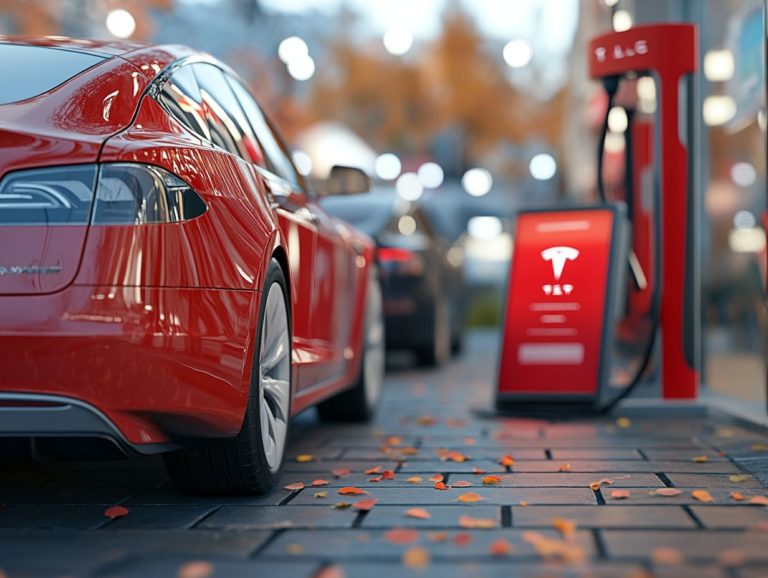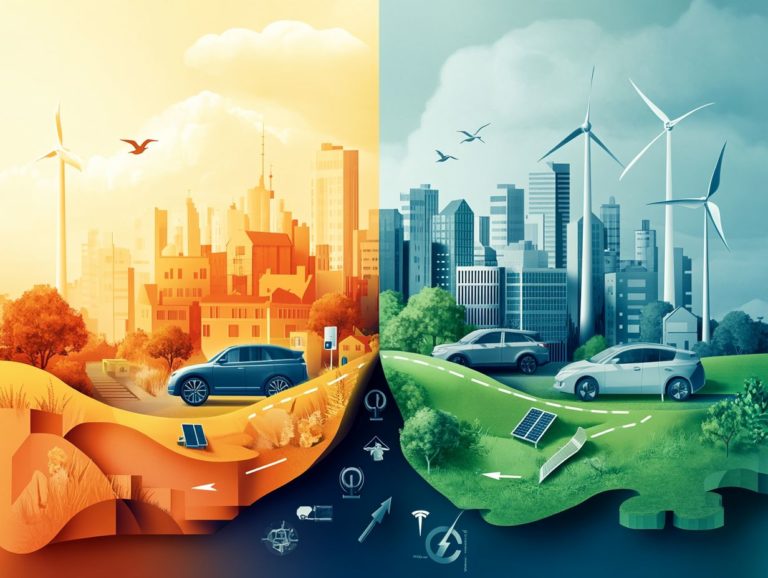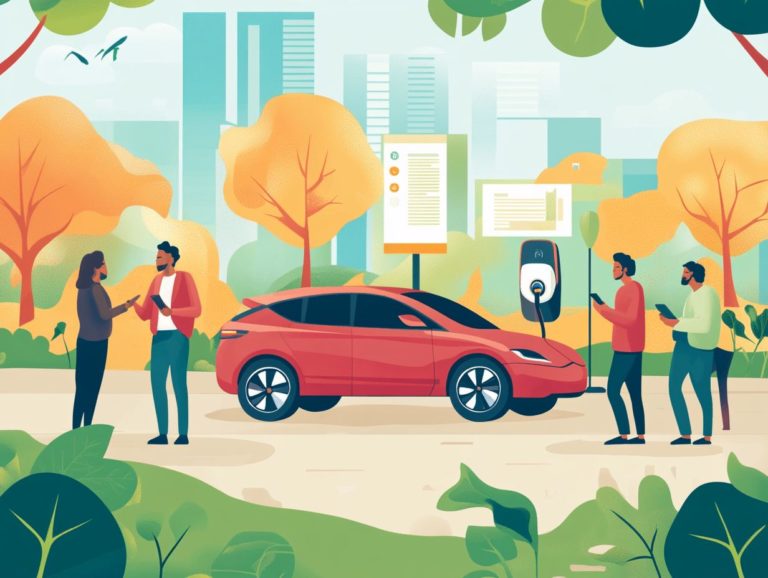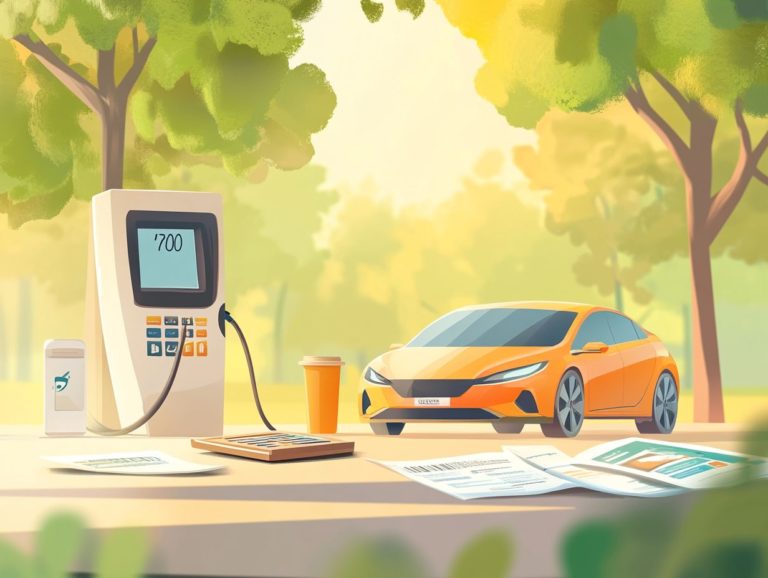the role of incentives in electric vehicle adoption
As the world embraces sustainable transportation, electric vehicles (EVs) are leading the charge in this exciting revolution. Let s explore the many benefits of electric vehicles together!
This exploration highlights their positive environmental impact and potential cost savings for consumers like you. While barriers such as high upfront costs and range anxiety exist, they are not insurmountable.
We will examine the crucial role of financial help discussing the various types available, their effectiveness, and real-world case studies from Norway and California that illustrate their impact.
Get involved and imagine the future with us as we discuss the transformative power of these incentives in the market.
Contents
- Key Takeaways:
- The Benefits of Electric Vehicles
- Barriers to Electric Vehicle Adoption
- The Role of Incentives
- Case Studies on Incentives and Electric Vehicle Adoption
- Future Outlook
- Frequently Asked Questions
- What are incentives and why are they important in electric vehicle adoption?
- What types of incentives are available for electric vehicle adoption?
- How do incentives affect the sales of electric vehicles?
- Do incentives only benefit individuals who buy electric vehicles?
- Are incentives the only factor that influences electric vehicle adoption?
- What is the future of incentives in electric vehicle adoption?
Key Takeaways:
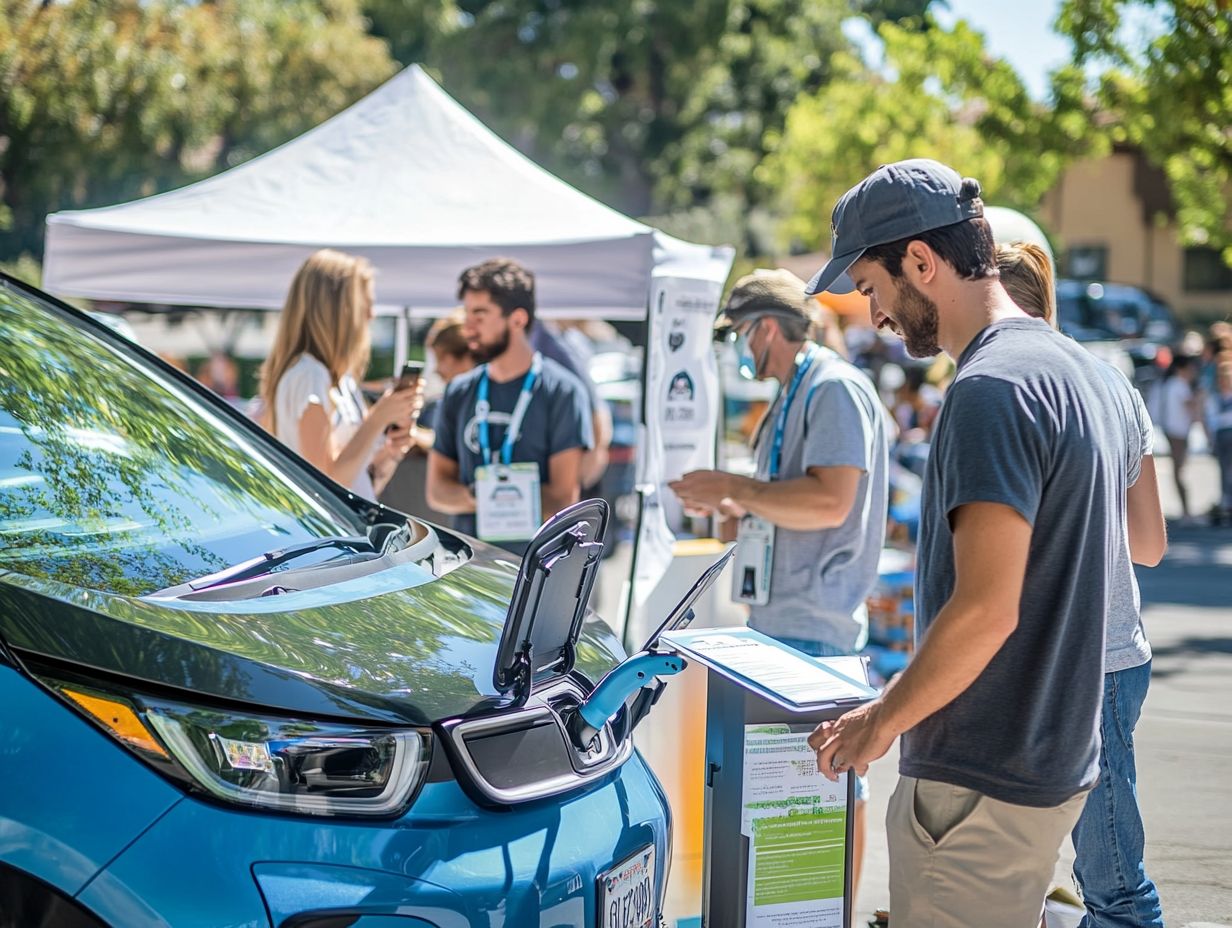
Financial help plays a crucial role in promoting the adoption of electric vehicles, addressing barriers such as high upfront costs and range anxiety. Norway and California prove that smart financial help boosts electric vehicle sales dramatically. The future growth of the electric vehicle market is closely tied to the implementation of policies and programs that make electric vehicles more accessible and attractive to consumers.
The Benefits of Electric Vehicles
Electric vehicles (EVs) signify a transformative shift in transportation, offering substantial environmental advantages by significantly reducing emissions typical of traditional gasoline-powered vehicles.
By embracing electric vehicles, you actively participate in the battle against climate change, helping to carve a path toward a cleaner, more sustainable future.
With the latest advancements in battery technology and an expanding charging infrastructure, the benefits of EVs extend beyond just environmental concerns leading to notable cost savings for you as a driver.
Understanding these advantages is essential as you navigate the transition toward cleaner transportation solutions in regions like California and Washington.
Environmental Impact
The environmental impact of electric vehicles is truly significant. They are essential in reducing the emissions that drive climate change and contribute to air pollution.
Compared to traditional gasoline-powered cars, which release considerable amounts of carbon dioxide and other harmful pollutants, electric vehicles produce far fewer greenhouse gases over their entire lifecycle.
A study by the Union of Concerned Scientists reveals that electric vehicles can achieve emissions reductions of up to 68% compared to conventional vehicles, depending on the energy source used for charging. This reduction plays a critical role in fighting global warming and enhances air quality, especially in urban areas plagued by smog and respiratory issues.
As cities increasingly adopt electric mobility, the long-term sustainability of these clean transportation solutions becomes more apparent, paving the way for healthier communities and a more resilient planet.
Cost Savings
Switching to electric vehicles not only enhances your impact on the environment but also provides substantial cost savings, making it a savvy economic choice.
By embracing this innovative technology, you can enjoy significantly lower fuel expenses, as electricity often costs much less than gasoline.
Maintenance expenses are usually reduced as well, given that electric vehicles have fewer moving parts and don t require oil changes.
There are many financial incentives available to support your transition to electric, from tax rebates to credits that can significantly lower the initial purchase price.
In states like Georgia and California, policies at the state level further enhance affordability, transforming electric vehicles into an increasingly appealing option for those mindful of their budgets.
Barriers to Electric Vehicle Adoption
Despite the numerous advantages that electric vehicles provide, you may encounter several barriers to their widespread adoption.
High upfront costs and range anxiety often linger in the minds of potential EV drivers, creating hesitation in making the switch.
High Upfront Costs

High upfront costs are a major barrier to adopting electric vehicles. They often deter potential buyers like you, even with long-term savings on fuel and maintenance.
This initial price tag stems from the expensive batteries and advanced technology that leave traditional vehicles in a more financially accessible position. However, many governments recognize the importance of promoting eco-friendly choices and have rolled out financial incentives such as tax rebates and grants.
This financial support can significantly offset the higher purchase cost, making electric vehicles much more appealing to you. Successful state-level policies in places like California and Oregon have demonstrated effectiveness, allowing residents to enjoy substantial savings while fostering a greener future.
Through such initiatives, the gap between conventional and electric vehicle pricing may be bridged, making cleaner transportation a viable option for a wider audience like yourself.
Range Anxiety
Range anxiety is a significant concern for you as a potential electric vehicle buyer, driven by worries about the charging infrastructure and the distance you can travel on a single charge.
Consider this: the average American drives about 30 miles a day, while many electric vehicles can cover anywhere from 150 to over 370 miles on a single charge. Yet, despite these impressive ranges, the unease remains. You’re likely thinking about whether you’ll be able to find an available charging station on longer journeys.
To alleviate these concerns, it s imperative to expand public charging infrastructure. It’s not just about increasing the number of charging stations; it’s also about making them more accessible to you. This way, you can confidently transition to an electric vehicle without the nagging fear of running out of battery.
The Role of Incentives
Incentives serve as a key driver for getting more people to buy electric vehicles, offering financial support and motivating consumers to embrace cleaner alternatives. For a deeper insight, consider understanding incentive trends for electric vehicles.
By leveraging these incentives, you can significantly enhance your transition to sustainable transportation options. Don’t miss out on these financial benefits that can make your switch to electric vehicles easier and more affordable.
Types of Incentives Available
Several financial incentives exist to encourage your adoption of electric vehicles, encompassing both purchase-based and use-based options.
Among these, tax rebates for purchasing electric vehicles shine brightly as a compelling incentive, offering substantial discounts that can significantly lower the overall cost and make EVs more accessible to you. Many regions also provide rebates for installing home charging stations, further easing the initial expenses associated with embracing electric.
However, it’s essential to recognize that these incentives can vary widely from one location to another, shaped by local policies and government initiatives. Such differences can significantly influence your decision-making process as you weigh the cost savings against the financial benefits available in your area.
Understanding these dynamics is crucial as you contemplate making the switch to electric.
Effectiveness of Incentives
The effectiveness of various policy incentives is pivotal in driving the growth of electric vehicle sales and shaping market dynamics.
Looking at these case studies reveals exciting insights into how effective these incentives can be! In regions like California and Georgia, these incentives have been monumental in sparking consumer interest and boosting sales figures. Take California’s Clean Vehicle Rebate Project, for example it offers substantial rebates that can significantly slash the upfront cost of an EV. This has triggered a dramatic surge in adoption rates, with nearly 50% of America’s EV market residing in this state.
On the other hand, Georgia’s tax credit, though somewhat variable, has provided essential financial relief to buyers, leading to an uptick in EV registrations.
While current programs have shown effectiveness, there s still ample room for enhancement. Streamlining application processes and increasing funding could amplify their impact, creating an environment where electric vehicles are even more accessible and appealing to consumers.
Case Studies on Incentives and Electric Vehicle Adoption
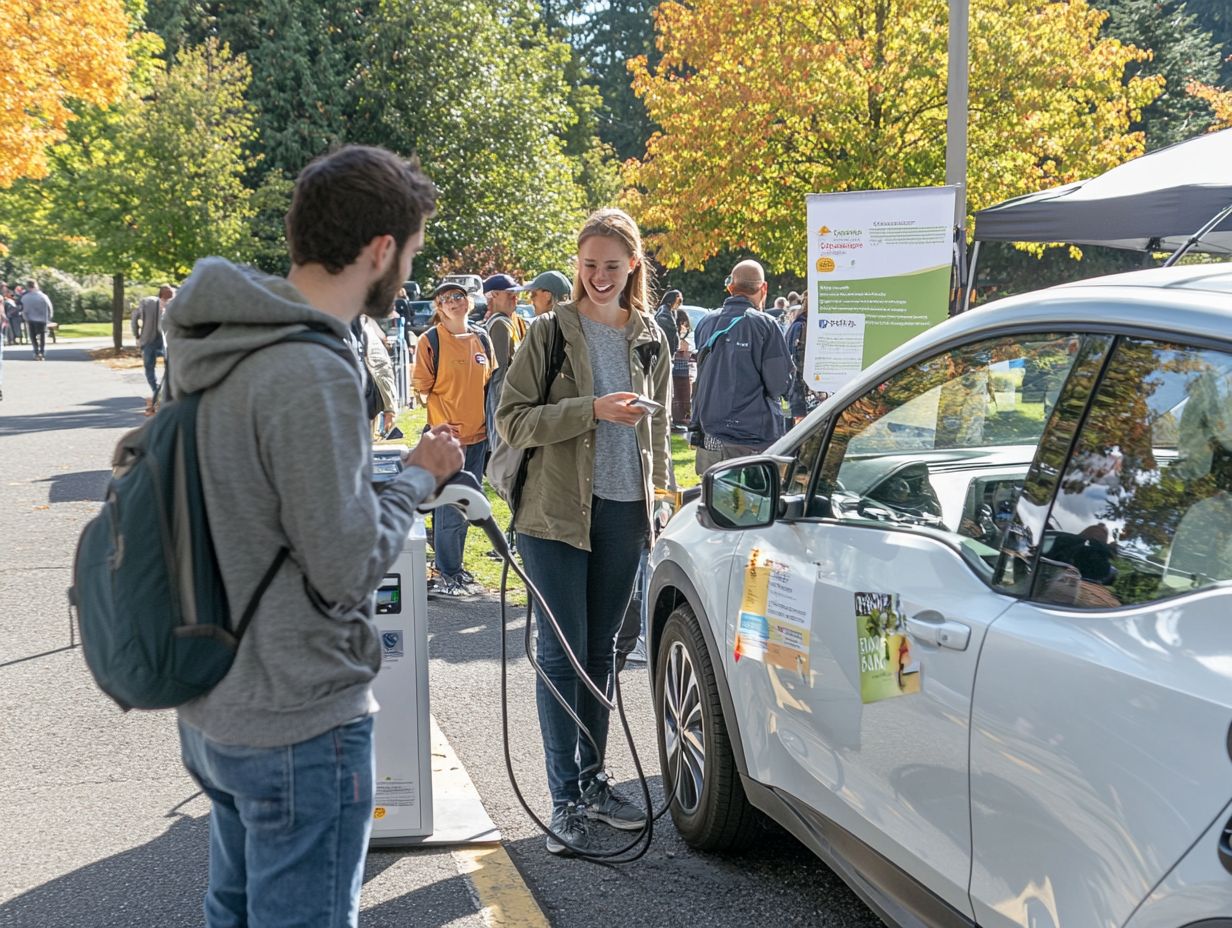
Case studies from regions like California and Norway provide invaluable insights into how policy incentives effectively promote electric vehicle adoption.
By examining these examples, you can better understand the strategies that drive success in this important transition.
Norway
Norway leads in electric vehicle adoption. Strong policies have significantly boosted EV sales.
In 2022, over 50% of all new car sales were electric vehicles. This shows how subsidies, tax breaks, and good charging stations change buying habits.
These incentives include exemptions from VAT and road tolls, as well as perks like free parking and access to bus lanes. This makes the transition to electric vehicles not just environmentally friendly, but also economically wise.
As a result, the total number of electric vehicles on Norwegian roads has surpassed 500,000. This reflects a significant shift in public sentiment toward sustainable transportation.
Such supportive policies have fostered an environment where choosing an electric vehicle is increasingly regarded as the norm, not the exception.
California
California has earned recognition for its bold policy incentives that accelerate electric vehicle adoption. Initiatives like the Clean Vehicle Rebate Project encourage you to switch to electric vehicles. This highlights the state’s commitment to environmental sustainability.
These financial incentives ease the initial purchase cost and cultivate a thriving market for EVs. As a result, sales in California have surged ahead of many other regions, showcasing the power of well-designed policies.
By exploring similar initiatives in states like New York and Washington, you can grasp the diverse impacts these measures have on promoting eco-friendly transportation across the country.
Future Outlook
The future of electric vehicles is thrilling! With more incentives, the road ahead is full of possibilities.
As efforts to enhance accessibility and affordability continue, anticipate a landscape rich with opportunity and innovation in sustainable mobility.
Potential Impact of Incentives on Electric Vehicle Market
The potential impact of incentives for EV buyers on the electric vehicle market is transformative, influencing everything from your purchasing decisions to market dynamics.
Incentives like tax credits, rebates, and better charging infrastructure create an enticing environment for first-time buyers and those considering switching from traditional vehicles.
Current trends reveal that as these incentives expand, the adoption rate of electric vehicles rises in tandem, with sales showing a notable year-over-year increase.
Consumer awareness is pivotal; when you recognize the long-term savings and environmental benefits of electric vehicles, you re more likely to embrace this shift.
Community engagement through local campaigns boosts the impact of incentives. This cultivates a collaborative atmosphere where consumers and manufacturers thrive, shaping a robust and sustainable electric vehicle ecosystem.
Frequently Asked Questions
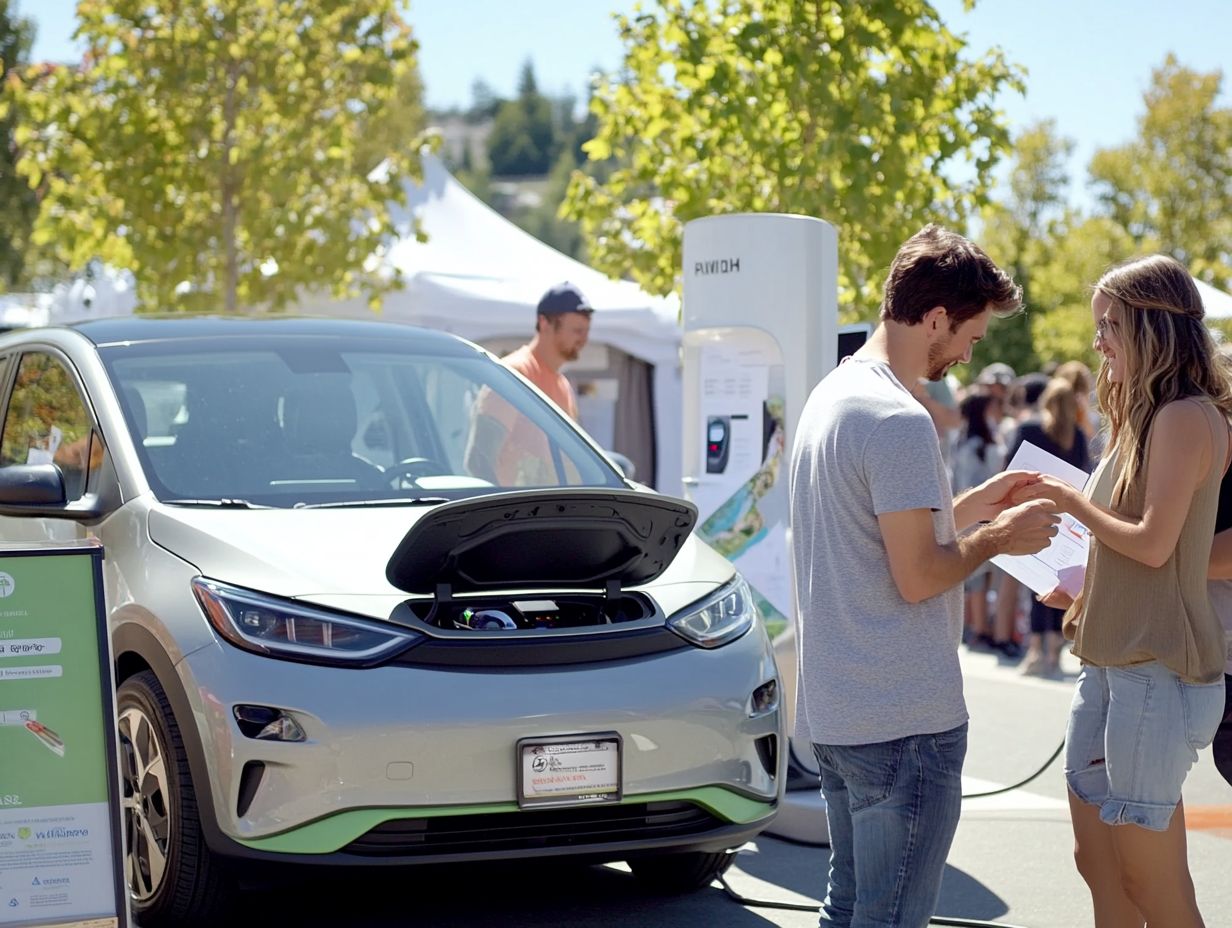
What are incentives and why are they important in electric vehicle adoption?
Incentives are rewards or benefits given to encourage a specific behavior. In the context of electric vehicle adoption, these incentives promote the purchase and use of electric vehicles. Understanding the role of local governments in EV incentives is important because they help offset the higher upfront costs, making them more appealing to potential buyers.
What types of incentives are available for electric vehicle adoption?
There are various types of incentives available for electric vehicle adoption, including tax credits, rebates, grants, and subsidies. Some states and countries also offer perks such as free parking or access to High Occupancy Vehicle (HOV) lanes, which are reserved for vehicles with multiple passengers to encourage carpooling.
How do incentives affect the sales of electric vehicles?
Incentives significantly boost the sales of electric vehicles. They make these vehicles more affordable, increasing their demand. In countries with generous incentives, many more people buy electric vehicles.
Do incentives only benefit individuals who buy electric vehicles?
No, incentives also help businesses and organizations that add electric vehicles to their fleets. They lower the purchasing costs and make electric vehicles a practical choice for commercial use.
Are incentives the only factor that influences electric vehicle adoption?
No, other factors affect adoption, too. These include the availability of charging stations, concerns about running out of battery power (known as range anxiety), and the overall cost of owning an electric vehicle.
What is the future of incentives in electric vehicle adoption?
Incentives will continue to evolve as electric vehicle technology advances and becomes cheaper. They may shift from simply helping buyers to encouraging EV charging incentives that promote charging station development and production efforts. The goal is to make electric vehicles a common choice for transportation, and these incentives are key to achieving this.

